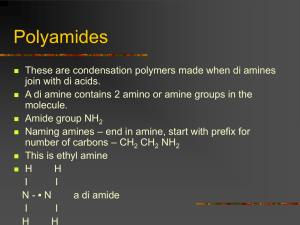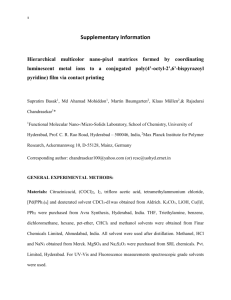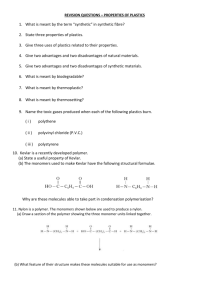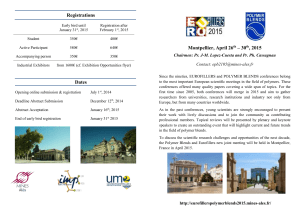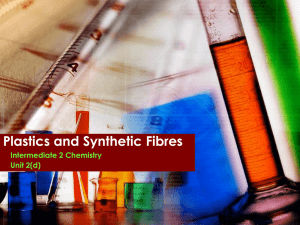May-June, 1997 - PEL Associates
advertisement
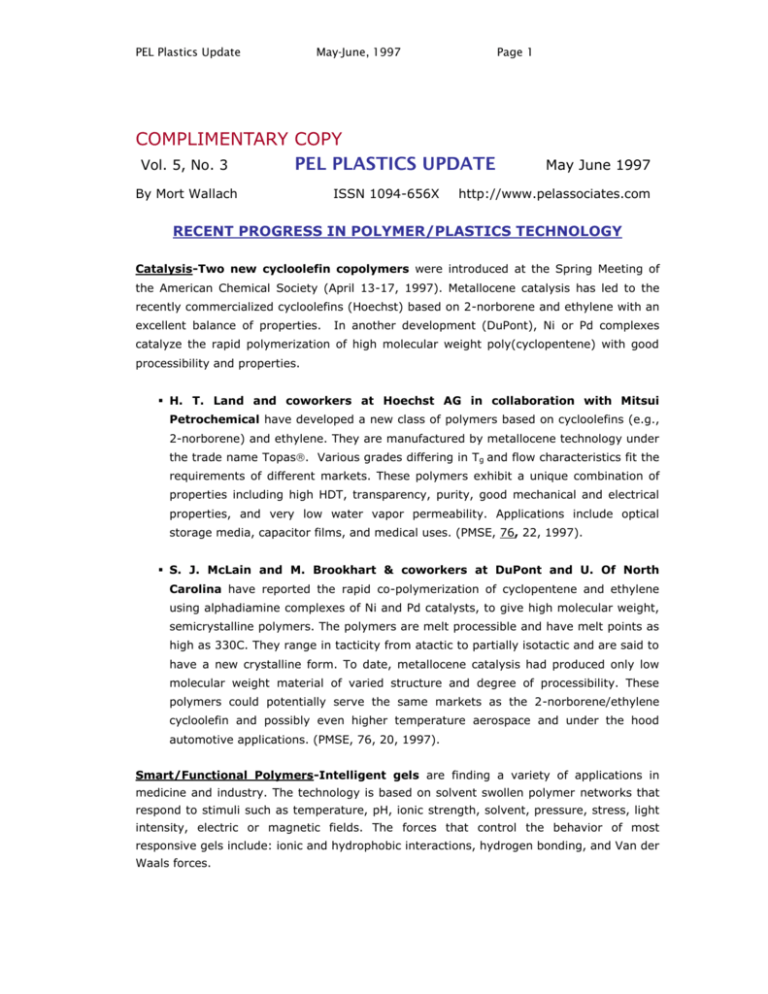
PEL Plastics Update May-June, 1997 Page 1 COMPLIMENTARY COPY Vol. 5, No. 3 PEL PLASTICS UPDATE By Mort Wallach ISSN 1094-656X May June 1997 http://www.pelassociates.com RECENT PROGRESS IN POLYMER/PLASTICS TECHNOLOGY Catalysis-Two new cycloolefin copolymers were introduced at the Spring Meeting of the American Chemical Society (April 13-17, 1997). Metallocene catalysis has led to the recently commercialized cycloolefins (Hoechst) based on 2-norborene and ethylene with an excellent balance of properties. In another development (DuPont), Ni or Pd complexes catalyze the rapid polymerization of high molecular weight poly(cyclopentene) with good processibility and properties. H. T. Land and coworkers at Hoechst AG in collaboration with Mitsui Petrochemical have developed a new class of polymers based on cycloolefins (e.g., 2-norborene) and ethylene. They are manufactured by metallocene technology under the trade name Topas. Various grades differing in Tg and flow characteristics fit the requirements of different markets. These polymers exhibit a unique combination of properties including high HDT, transparency, purity, good mechanical and electrical properties, and very low water vapor permeability. Applications include optical storage media, capacitor films, and medical uses. (PMSE, 76, 22, 1997). S. J. McLain and M. Brookhart & coworkers at DuPont and U. Of North Carolina have reported the rapid co-polymerization of cyclopentene and ethylene using alphadiamine complexes of Ni and Pd catalysts, to give high molecular weight, semicrystalline polymers. The polymers are melt processible and have melt points as high as 330C. They range in tacticity from atactic to partially isotactic and are said to have a new crystalline form. To date, metallocene catalysis had produced only low molecular weight material of varied structure and degree of processibility. These polymers could potentially serve the same markets as the 2-norborene/ethylene cycloolefin and possibly even higher temperature aerospace and under the hood automotive applications. (PMSE, 76, 20, 1997). Smart/Functional Polymers-Intelligent gels are finding a variety of applications in medicine and industry. The technology is based on solvent swollen polymer networks that respond to stimuli such as temperature, pH, ionic strength, solvent, pressure, stress, light intensity, electric or magnetic fields. The forces that control the behavior of most responsive gels include: ionic and hydrophobic interactions, hydrogen bonding, and Van der Waals forces. PEL Plastics Update May-June, 1997 Page 2 Since Tanaka’s observation at MIT in 1975 of a temperature dependent phase transition in a polymer network of polyacrylamide gel, there has evolved a large research effort aimed at gaining a better understanding of these smart materials and improving their properties and performance in many useful applications. Some recent products under development or recently commercialized include: a shoe insert which is soft and pliable at room temperature but becomes firmer when exposed to body heat (Smart Gel from GelMed), and skylights or greenhouse windows with hydrogel placed between plastic sheets wherein the hydrogel becomes translucent and reflective when it is warmed to a preset temperature or exposed to a bright light (Cloud Gel from Suntec), and a variety of interesting and important medical applications including drug delivery and skin care. Another development nearing commercialization-Smart Hydrogel from GelMed-consists of an entangled network of two randomly grafted polymers. One is poly(acrylic acid) (PAA) which is bioadhesive and pH-responsive. The other is a triblock copolymer of PEO/PPO/PEO (Pluronic polyols) a well-known drug carrier with hydrophobic PPO segments which aggregate leading to gelation at body temperature. The aggregates form micelles, which solubilize lipophilic drugs in aqueous media and allow their slow release for targeted products including longer lasting eye drops, nasal sprays and sunscreens. In another example, a Duke U./Access Pharmaceutical team is developing microscopic hydrogel beads to deliver drugs directly into tumors, i.e., an artificial secretory granule. This synthetic organelle consists of a spherical 5 m particle of a copolymer from methacrylic acid and N,N’methylenebisacrylamide (a cross-linking agent). The hydrogel can absorb 200% of its weight in doxorubicin, which is a potent anticancer drug. Once loaded with the drug, the particle is coated with a lipid bilayer to keep the beads intact long enough to be filtered out of the blood by the tumor. Disruption of the lipid coating leads to the required quick release of the drug to provide a therapeutic concentration to the tumor. Ongoing work by this team includes development of needed smaller particles, new technology to coat the nanoparticles, and biocompatible/biodegradable hydrogels that will degrade into soluble materials that can be secreted by the kidneys. Other areas being investigated include: the expansion and contraction of gels to allow chemical or electrical energy to be converted into mechanical work and increasing their response time when subjected to an electrical impulse, e.g., potential material for artificial muscle, gels that expand and contract on heating by a magnetic field, oscillating gels which respond to an internal stimulus, gels whose composition is so designed that in response to a specific stimulus they spontaneously bend or curl into a predetermined shape, and gels which harden when they swell. The great sensitivity of gels to stimuli as small as one-degree temperature change may well lead to many other useful applications. (R. Dagani, C&EN, June 9, 1997, p.26). PEL Plastics Update Alloys & Blends-Reactive May-June, 1997 processing compatibilizing important blends. Page 3 continues to prove most effective in In this example, poly(butylene terephthalate) (PBT) is modified with functional polyolefins which yields better interfacial adhesion and resulting properties than corresponding blends of PBT with non-functional polyolefins. T-K. Kang and coworkers at Pusan National U. in South Korea have investigated the physical properties and morphology of blends containing poly(butylene terephthalate) (PBT) with several functionalized polyolefins. Special focus was put on PBT/EVA-g-MAH and PBT/EMA-g-MAH blends compared with PBT/EVA and PBT/EMA. Blends were prepared in a counter-rotating twin-screw extruder. Mechanical and thermal properties, glass transition temperature and morphology were examined. PBT/EVA-g-MAH and PBT/EMA-g-MAH exhibited better properties (e.g., impact strength) than PBT/EVA or PBT/EMA blends. The results are consistent with the in-situ formation of a graft copolymer by reaction of PBT hydroxyl end groups with maleic anhydride. The graft copolymer then acts as an emulsifier to decrease the interfacial tension and reduce the tendency of dispersed particles to coalesce, and promotes adhesion between the blend phases. (Polym. Eng. Sci., 37, 603, 1997). Alloy & Blend Patents-Among 550 patents reviewed during this period, several noteworthy inventions were selected including: new polypropylene copolymer blends, a process for making clear/transparent PET pre-forms, stilbenediol based polyester and polycarbonate compositions, composite polyester/polyamide fibers, an additive for improved processibility of mLDPE, and multilayer polymer compositions for fuel tanks. “Propylene Polymer Blends And Films And Articles Made Therefrom”. Michael C C. Chen et. al. (Exxon Chemical Patents Inc.) WO 97 10,300, Mar. 20, 1997. The blend comprises 25-75% propylene copolymers having molecular weight distribution > 2.5, and 25-75% metallocene produced isotactic propylene copolymers containing >80% propylene units and from 0.2-10% C>5 -olefins. Films made from such blends exhibit low extractables, enhanced heat seal performance, clarity, gloss, and toughness when compared to films produced from conventional copolymers. The balance of film properties achieved is unique compared to films made from the individual components of the blend. (Chem. Abs. 126: 278640k). “Injection Molding Process For Formation Of Polyester Pre-Forms And Blow Molding Process Thereafter”. H. Nakajima et. al. (Aokiko Kenkyusho Kk) JP 09 52,277, Feb. 25, 1997. In order to prevent the formation of gel-like materials which produce nontransparent pre-forms, the PET and poly(ethylene naphthalate) blends are molten in rotating screws consecutively including compression zones, plasticizing zones for repeatedly kneading and relaxing, and gauging zones, before injection molding the pre-forms. The pre-forms are preferably blown into thin bottles by hot the parison method. A blend of 90% Unipet 8 PET and 10% 8:92 ethylene (E) terephthalate/E di-Me 2,6-naphthalate copolymer was molten, PEL Plastics Update May-June, 1997 Page 4 injection molded and drawn/blown to form a bottle for drinking water. (Chem. Abs. 126: 252088m). “Stilbenediol-Based Polyester And Polycarbonate Compositions”. Stephen E. Bales et. al. (Dow Chemical Co.) US 5,614,599, Mar. 25, 1997. A polycarbonate, polyester, or polyester-polycarbonate composition is prepared from a reaction mixture comprising >1 diol and/or >1 carbonate or C8-40 carboxylic acid ester precursor, >95 mol% selected from (I) dialkylcarbonates, diarylcarbonates, carbonyl halides, and bis(trihaloalkyl) carbonates; and (II) aromatic dicarboxylic acids, hydroxybenzoic acids, hydroxynaphthoic acids, hydroxybiphenyl acids, hydroxycinnamic acids, and the halides or metal salts of such acids; and >95 mol% of the diol present in the reaction mixture consists of >1 aromatic diols, >10 mol% of which consists of >1 stilbene diols. The composition has a relatively high thermal resistance, melting temperature, tensile and flexural properties, and/or resistance to thermal embrittlement. The polymers which show thermotropic liquid crystals, also advantageously possess a broad temperature range for liquid crystallinity, good melt processibility, a low coefficient of thermal expansion, a high ignition resistance, high solvent resistance, and/or good barrier properties. (Chem. Abs. 126: 293763w). “Polyester-Polyamide Composite Fiber”. H. F. Simons (Hoechst Celanese Corp.) EP 763,611, Mar. 19, 1997. Composite fibers containing polyesters and polyamides incompatible with the polyesters also contain a polymer to improve adhesion of the polyamide component. The adhesion-promoting polymer is blendable with the polyamide component. A typical composite fiber comprises a PET core and a sheath of 90:10 nylon 6 (PET incompatible component) - nylon 12 blend. (Chem. Abs. 126: 294527j). “Improving Processibility Of Metallocene-Catalyzed Thermoplastics Using A Minor Amount Of Poly(1-Butene)”. Ch. C-H. Hwo et. al. (Shell Oil Co.) EP 767,208, Apr. 9, 1997. The processibility or extrusion efficiency of metallocenecatalyzed thermoplastics, particularly low density polyethylene, are improved by adding ~0.1-15 wt.% of poly(1-butene) with melt index ~10-1000 dg/min (190C, ASTM D 1238E) to the thermoplastics which are melt incompatible with poly(1butene) prior to processing. The poly(1-butene) appears to lubricate the surface of the polymer melt. Thus, dry blending Affinity FM 1570 (low density polyethylene) 97.5 and Duraflex DP 0800 [poly(1-butene)] 2.5% and extruding showed the requirement for extruder back pressure 650 psi and electric current 9 amp, compared with 850 and 12, respectively, for Affinity FM 1570 alone. (Chem. Abs. 126: 294230g). PEL Plastics Update May-June, 1997 Page 5 “Multilayer Molded Polymer Composition Using A Compatibilizer Bonding Polyolefin Layer With Immiscible Polymer Layer For Fuel Tank And Its Manufacture”. M. Nul- man et. al. (Ford Motor Co.) US 5,618,599, Apr. 8, 1997. Three layer fuel tank containing high density polyethylene (HDPE) layers and barriers comprising a blend of 99-85% ethylene vinyl alcohol copolymer (EVOH) and 1-15% compatibilizer of functional polycaprolactone - or poly(vinyl acrylate) grafted polyolefin is manufactured by extruding a three layer laminate having barrier material between two HDPE layers where the compatibilizer bonds with both HDPE layers and EVOH layer. Thus, polypropylene-graft--caprolactone compatibilizer was distributed on top of HDPE plaque, an EVOH layer was placed on top of the compatibilizer and the composite layer was compression molded for 20 min at 300 psi and 220C to give a product showing peel strength (FLTM B 0101-06) 0.3 (initial) and 0.255 kN/m (after gas immersion), compared to 0 and 0, respectively, for a sample without compatibilizer. (Chem. Abs. 126: 278645r). “Nanostructure Technology”. Nanoscopic polyamide organic-inorganic hybrids were developed for application to microelectronic insulating materials. Also, novel nanostructured self-assemblies with enhanced optical and electronic properties were obtained from unique polymer blends and composites made with a poly(phenylene vinylene) derivative. “J. L. Hedrick and coworkers at IBM Almaden and T. J. Watson Research Centers” have demonstrated the preparation of organic-inorganic hybrids with nanophase morphologies. These polyimide-silica hybrids offer a wide range of properties (including low dielectric constant and high modulus), and the sol-gel process allows one to properly incorporate a polymeric material into the precursor solution. The process involves hydrolysis and condensation of a Group IV metal oxide in solution with subsequent formation of a network structure. Various poly(silsesquioxane) resins were chemically modified with triethoxysilyl functionalized poly(amic ethyl ester) oligomers. This oligomer is hydrolytically stable and has a higher imidization temperature than the amic acid that prevents coarsening and loss of nanostructure. The latter occurs when hydrogen bonding between organic and inorganic components is lost on imidization. The oligomer is prepared from PMDA by ethanolysis, followed by separation, and conversion to the acid chloride. Polymerization with the target diamine yields the poly(amic ethyl ester). Film prepared with the polyimide-silica hybrid had toughness which was enhanced by incorporation of the polyimide with no loss in thermal stability or dielectric constant of the film.. Possible use as a microelectronic interlayer dielectric is envisioned. (Polymer Preprints, 38, 985, 1997). PEL Plastics Update May-June, 1997 Page 6 “C. Y. Yang and coworkers at U. of California, Santa Barbara” found that nanostructured hexyloxy)-1,4- self assemblies phenylene with vinylene] have MEH-PPV=poly[2-methoxy-5-(2’ethylenhanced electronic and optical properties compared to those of MEH-PPV alone. The self assemblies consist of blends of MEH-PPV with polyquinoline and polyaniline, and the composite MEH-PPV with PEO and with buckminsterfullerene [C60 ]. Phase separation in the blend leads to formation of a nano-scale network structure. Light emitting electrochemical cells were fabricated with nanostructured PEO/MEH-PPV blends that show fast response and energy efficiency. The homogeneous nanostructured network of C60-MEH-PPV 1:1 composite is a bulk heterojunction material which exhibits photovoltaic efficiency of more than two orders of magnitude larger than that of neat MEH-PPV devices. (Synth. Met., 84, 895, 1997). Dr. Mort Wallach has over twenty-five years experience in the plastics industry beginning at DuPont's Experimental Station, and ranging from resin, film, and plastic manufacture, to consumer products, transportation and aerospace. His contributions include twenty-four publications, four recent books, numerous patents, and key roles in commercial developments, such as Kapton polyimide film, high performance composites, novel consumer products, and engineered materials. Presently, he is President of PEL Associates, a successful product development and consulting firm in polymer/plastics science and technology. He is a member of ACS, SPE, IUPAC, and Sigma Xi. Dr. Wallach is affiliated with: Teltech Network of Experts, The CT Technology Council, Univ. of Connecticut, The Fulbright Association, and The Licensing Executives Society. PEL Plastics Update May-June, 1997 Page 7 Subscription Order Please enter my subscription to PEL PLASTICS UPDATE. Online subscription (1 year) to 27 issue database (1995-2002) only $60/year. Single issues can be obtained for $20 each.* Total amount enclosed $_____ (Check or Money Order). Guarantee: Full immediate refund if not totally satisfied. Send Subscription Order To: Dr. Morton L. Wallach, PEL Associates 1084 Shennecossett Rd. UCONN – Avery Point Groton, CT 06340 Please indicate your address below: Name Company Address City State Zip Country PEL PLASTICS UPDATE highlights recent progress in key areas of polymer/plastics technology and applications including: catalysis, biopolymers, smart/functional polymers, alloys & blends, nanotechnology, polymer modification and new ventures. Highlights are selected from a review of over 1000 articles in 100 journals, over 1000 US and foreign patents, and key conferences worldwide.
